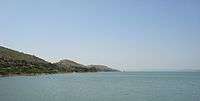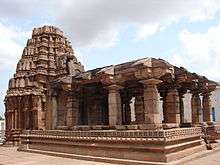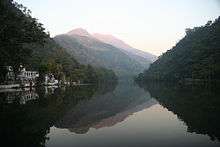Renuka
Reṇukā/Renuga/Renu is a Hindu goddess worshipped predominantly in the Maharashtra and southern Indian states of Karanataka, Telangana, Andhra Pradesh, and Tamil Nadu.[1] Renuka's temple at Mahur in Maharashtra is considered one of the shakti peethas.
| Renuka | |
|---|---|
The icon of Renuk at the sanctum of the Mahur temple, a Shakti Peetha | |
| Devanagari | रेणुका |
| Sanskrit transliteration | Rénûka/Renu |
| Affiliation | devi |
| Abode | Mahur |
| Mount | Lion |
| Personal information | |
| Consort | Jamadagni |
| Children | Parshurama, Vasu |
Different names
Renuka/Renu or Yellamma or Ekvira or Ellai amman or Ellai amma (Marathi:श्री. रेणुका/ येल्लुआई (Shree Renuka/ Yelluai), Kannada: ಶ್ರೀ ಎಲ್ಲಮ್ಮ ರೇಣುಕಾ, Telugu : శ్రీ రేణుక/ ఎల్లమ్మ, Tamil: ரேணு/Renu) is worshipped as the goddess (devi) of the fallen, in the Hindu pantheon. Yellamma is the patron goddess of the Maharashtra and the south Indian states of Telangana, Andhra Pradesh, Karnataka and Tamil Nadu. Her devotees revere her as the "Mother of the Universe" or "Jagadamba".
Origin story
The legends of Renuka are contained in the Mahabharata, the Harivamsa and in the Bhagavata Purana.Goddess Renuka is known for her chastity.Once her husband Jamadagni felt thirsty and asked water to his wife but Renuka devi could not find water anywhere due to the drought so she with the help of her chastity went to kailash with her mortal body and asked Lord Shankara to give ganga to quench her husband thirst.

Early life
King Reṇu (father of Reṇukā) performed a yajna — a ritual performed to maintain peace and good health. He was blessed with a daughter, who originated from the fire of this yajna. Reṇukā was a bright and active child and became the most beloved child of her parents.
When she was eight, Agastya, who was the guru of king Reṇu, advised him to have his daughter married to Jamadagni when she reached maturity. Jamadagni was the son of Ruchik Muni and Satyavati and had obtained the blessings of the gods by performing severe penance. Renuka and Jamdagni Muni lived in the Ramshrung mountains, near the present day Savadatti area of Belagavi district. Renuka helped the Jamdagni Muni in all of his tasks of performing various rituals and puja. Gradually she became close and dear to Jamdagni. After a while Renuka was blessed with another daughter called Anjana (Anjana Devi). Renuka would wake up early in the morning to bathe in the Malaprabha River with complete concentration and devotion. Her devotion was so powerful that she was able to create a pot to hold water made only of sand, one fresh pot every day. She would fill this pot, on the bank of the river and would use a snake which was nearby, turning it into a rope-like convolution and placing it on her head, so that it supported the pot. Thus, she brought the water to Jamdagni for his rituals of oblation. ("Renuka" is derived from the Sanskrit for "fine grain of sand".) Another temple of Renuka is situated at near Zamania, Ghazipur.. There is another temple in Tamilnadu near vellore (padaiveedu) where the goddess is in the form of suyambu ( the idol itself originated from the land).
Later life
Renuka gave birth to five sons: Vasu, Viswa Vasu, Brihudyanu, Brutwakanwa and Rambhadra. Rambhadra was the youngest and most beloved, gaining the favour of Lord Shiva and Parvati and hence called Parashurama (the sixth incarnation of Vishnu).[2] One day when Renuka went to the pond, she saw Gandharva a heavenly being's reflection in the pond who was flying over the pond with his wife. She just thought that the gandrava is beautiful for a moment. she lost her concentration and devotion to her husband for a moment as she started thinking about another man. As she was distracted, she lost her power of collecting water in unbaked pots, which she had gotten from her chastity. She lost the water which she had collected. Disappointed by this, she returned to the ashram in worry.Jamadagni saw all these events through his yogic power. Jamadagni became furious and angrily ordered her to go away.
After being cursed by her husband, Renuka went east and sat in the forest to meditate. In her penance, she met with the saints Eknath and Joginath; she prayed to them and asked to gain the mercy of her husband. They first consoled her, then instructed her to follow their advice exactly as told. They told her to purify herself, first bathing in a nearby lake, and then to worship a Shivalinga, which they had given to her. Next, she should go to the nearby town and beg for rice from the houses (this ritual, called "Joga Bedodu", is still carried out by women during a particular month in Karnataka/ "Jogawa" in marathi, "Yellamma Jogu" in Telangana).
After collecting the rice, she was to give half to the saints and cook the remaining half, adding jaggery, partaking of the cooked rice with full devotion. They said that if she performed this ritual for three days, she would be able to visit her husband on the fourth day.

Knowing the anger of Jamadagni, they warned her that she may not be fully pardoned by him, and that she would have to experience the most difficult time of her life for a few minutes. "After that," they said, "you will be eternally revered and will be blessed with your husband. You will be worshiped by all the people henceforth." After blessing her this way, they disappeared. Renuka followed their instructions with devotion and worshipped the Shivalinga with full care and reverence. On the fourth day, she went to see her husband.
Punishment and resurrection
Jamadagni was still furious with Renuka and ordered his elder four sons to kill Renuka Devi but all of them refuse to kill their mother. Jamadagni,cursed his four sons to become stone for disobeying his order. Jamadagni called his fifth son Parashurama who was meditating on Lord Shiva and ordered him to behead Renuka devi. Parashurama immediately obeyed his father's words and beheaded his mother with his axe. Though Parashurama is devoted to his mother he didn't wish to disrespect his father's words because father's words are superior than vedic mantras .Jamadangi was very much pleased by Parashurama's devotion towards him.
He then offered a boon to Parushurama, who asked for his mother and brothers to be brought back to life. To everybody's astonishment, Renuka's spirit multiplied and moved to different regions. Renuka was back as a whole too. This miracle inspired her sons and others to become her followers, and worship her.
Renuka vs. Yellamma
In many traditions, Renuka and Yellamma are taken to be two names for the same goddess. However, there is also an oral tradition that distinguishes between the two. According to these tales, Renuka fled to a fisherman community when her son Parushurama was coming to kill her.A woman belonging fishing community helped Renuka Devi and asked her to hide in her hut. Parashurama found and beheaded her, along with the woman who belongs to fishing community who had tried to protect Renuka Devi . When he later brought them back to life, he mistakenly attached the woman's head to Renuka's body, and vice versa. Jamadagni accepted the former as his wife Renuka, while the latter remained to be worshipped by all caste people as Yellamma, the mother of all. Matangi, Renuka, and Yellamma are all names of the Goddess.[3]
Temples and related places
One of the famous temples of Renuka Yellamma Thalli is located at Balkampet in Hyderabad where every year in Ashadha month Yellamma Kalyanothsavam is celebrated with thousands of pilgrims performing special rituals to get the blessings of Renuka Yellamma Thalli. The idol of the goddess, interestingly, is 10 feet deeper than the ground level. There is also a well in the Balkampet Yellamma temple complex and some devotees believe that the water in the well heals all ills. Therefore, a bath here is supposed to purify you of all disorders and skin diseases. This holy water is called ‘Theertham’. An Akhand_Jyoti is also present in the temple that was lit during the renovation. In fact, Nita_Ambani wife of India's richest person Mukesh_Ambani visits the temple whenever she is in Hyderabad to express her faith in the deity.
Every year, there is a gathering of as many as 200,000 of her devotees at the Yellamma Gudi temple (Yallamma Temple) in Saundatti.
Two other Very famous Temple of Renuka Yellamma is located in Bidarahalli, Gadag, and chandragutti, shivmoga, Karnataka, India . Many devotees from different region come to temple in the month of kartik to celebrate Karthik of Renuka-Yellamma. It is Believed that after marriage with sage Jamadagni, Renuka devi lived in this place. Renuka used to wake up early in morning and have bath in the holy Tungabhadra River. With complete concentration and devotion to fill the pot, which she used to prepare out of the sand on the bank the river and would hold the snake which was there and turn it into a convolution and place it on head so that it supported to the pot. She bought the pot to Jamdagni for performance of rituals.
Another temple Renukambe [Yellamma] is atop a hill in Chandragutti, Soraba Taluk in Shimoga. This temple is an example of ancient architecture and dates back to the Kadamba period. Another temple is in Mahur, Maharashtra, the supposed birthplace of the goddess, which finds mention in Devi Gita, the final chapter of Devi Bhagawatam as, "Matripura in the Sahyadri mountain; here the Devi Renuka dwells ...".[4]
One of the temple of Renuka Devi is Chandwad in Nasik. The temple was constructed by her highness Maharani Ahilya Devi Holkar of Indore There is a great place of pilgrimage named Kolhapura in the southern country. Here the Devi Laksmi always dwells. The second place is Matripura in the Sahyadrî mountain; "Renuka dwells."
Another Temple of Devi is at Dhamnand-Posare, Taluka:Khed, District Ratnagiri, Maharashtra known as "Devi Yalubai"; Verses: 3-10.[5] Another temple becoming famous is Nalgonda, Telangana where Tuesday is main auspicious day.
In Tamil Nadu, Renugambal Amman Temple (it is kuladeivam for jambu maharishi (jamadagini)gotra vanniyars) ,senguntha Muthaliyars and other community people tracing their origin in that locality, the temple is situated in Padavedu, Thiruvannamalai District and it is one of the most important Sakthi Sthalas.[6]

Renuka Lake in the Renuka Sanctuary in Himachal Pradesh is named after the goddess. According to one legend, King Sahasrarjuna (Kartavirya Arjuna) wanted the Kamadhenu cow from Jamadagni and Renuka. So for this he killed Jamadagni, and Renuka became sati along with Jamadagni at Mahurgadh, Maharashtra.[7]
Another famous temple for Renukambal is situated in Serampattu Village near Cheyyar in Tiruvannamalai district. Thousands of people gather here during Pongal festival. Another powerful temple of Renuka Parameshwari is located in Tiruchampalli near Sembanarkoil in Nagapattinam district of Tamil Nadu.
One more temple of Ellamma is situated at a village of Ragupathi Naicken Palayam of Erode, Tamilnadu. Ragupathi Naicken Palayam can be reached from Erode - Poondurai Road as well as Erode - Vellode Road. Although it is unclear when the temple was constructed, it is understood from the inscription placed at the temple that the temple was renovated by Late Mr. Duraisamy Naicker in 1923. He is said to belong to community of Banajiga (or Balija) of Lingayat Society which has origin in Karnataka, but settled in Tamilnadu in 19th century. The temple is maintained by people of the Banajiga community now. Maha Shivarathiri in the month of Maasi and Full Moon day of Karthigai are celebrated by the Banajigas in this temple.
Goddess Renuka and Lord Jamdagni Muni are worshiped in villages around yamuna river in Rawain valley of Uttarkashi district in Uttaranchal. Many ancient temples in the region are dedicated to the divine couple – the famous being the Jamadagni temple at Thaan village near the bank of yamuna and Renuka temples in uphill village of Devadokhri, Banchangaon, and Sarnaul. The region has an age-old tradition of celebrations in commemoration of the local deities, and managing the temple affairs and customs. The priesthood is claimed on the basis of ancestry and merit both, and mainly held by Khanduri, Semwal, and Dimri Brahmins of Uttaranchal. The week-long annual festivities in the month of June are main attraction for the devotees around the region.
In Sri Lanka
In ancient Sri Lanka, "Renuka" was the name of a minor goddess of wanton death and destruction, although at certain times was also a symbol of creativity and vibrancy.
Further reading
- The Village Gods of South India (London, 1921) by H. Whitehead
- Yellamma: A Goddess of South India (1995) by Channappa Uttangi
- Given to the Goddess: South Indian Devadasis and the Sexuality of Religion (2004) by Lucinda Ramberg
- Melissa Hope Ditmore, ed. (2006). Encyclopedia of Prostitution and Sex Work: A-N. Vol. 1. Greenwood Publishing Group. pp. 103–104. ISBN 9780313329685.
References
| Wikimedia Commons has media related to Renuka. |
- "Sri Renuka Amman Parameswari". Archived from the original on 18 May 2015. Retrieved 29 April 2015.
- Sunil.A.Shah (May 2010). "ચિરંજીવી, શૌર્યતા, જ્ઞાનના સંગમ સમાન ભગવાન પરશુરામ" [Ciran̄jīvī, śauryatā, jñānanā saṅgam samān Bhagavān Paraśurām]. Divya Bhaskar (in Gujarati). Retrieved 29 April 2015.
- Pattanaik, Devdutt (2003). Indian Mythology. Inner Traditions / Bear & Co. p. 17. ISBN 978-0-89281-870-9.
- "Chapter XXXVIII: The Vow and the Sacred Places of the Devi". The Devi Gita [Song of the Goddess]. Excerpt from the Srimad Devi Bhagawatam. Translated by Swami Vijnanananda (Hari Prasanna Chatterji). 1921.
O King of Mountains! Still I am now telling something out of My affection to My Bhaktas. Hear.
- "Devi Yalubai". Verses: 3-10. Archived from the original on 12 October 2013. Retrieved 3 March 2013.CS1 maint: BOT: original-url status unknown (link)
- "Arulmigu Renugambal Amman Temple, A.K. Padavedu". Archived from the original on 8 January 2014.
- Kohli, M.S. (2002). Mountains of India Tourism, Adventure, and Pilgrimage. Indus Publishing. p. 303. ISBN 978-81-7387-135-1.
